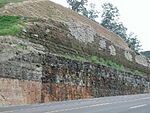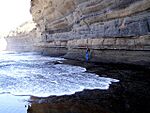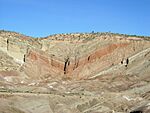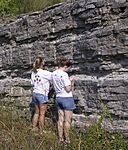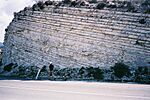Stratum facts for kids
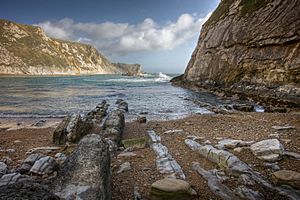
A stratum (plural: strata) is like a layer of rock or soil. Think of it as a page in Earth's giant history book! These layers form over millions of years. Scientists called geologists study strata. They learn about Earth's past, like what the land looked like. They also discover what the climate was like. And they find out what plants and animals lived long ago.
Contents
How Do Rock Layers Form?
Strata usually form from tiny bits of material called sediments. These can be sand, mud, or small rock pieces. They settle at the bottom of oceans, lakes, or rivers. Over millions of years, these sediments get pressed together. Heat and pressure turn them into solid rock. This process is called lithification.
Sometimes, strata can also form from volcanoes. When hot lava flows and cools, it makes layers of igneous rock. Geologists can study these layers too.
Gallery
-
Rock strata at Depot Beach, New South Wales
-
Rainbow Basin Syncline in the Barstow Formation near Barstow, California. Folded strata.
-
Chalk Layers in Cyprus showing classic layered structure
-
Heavy minerals (dark) as thin strata in a quartz beach sand (Chennai, India)
-
Stratified Island near La Paz, Baja California Sur, Mexico
Why Are Strata Important?
- Each stratum shows a specific time period. By studying the layers, geologists can figure out what happened on Earth millions of years ago. For example, chalk layers are made from tiny algae called coccoliths. These lived in the ocean during the Cretaceous period.
- Fossils are often found in strata. These are the preserved remains of plants and animals. They lived a very long time ago. By studying fossils in different layers, scientists learn how life on Earth has changed.
- Strata can show patterns of climate change. For example, layers of clay and sandstone might tell us about sea level changes. This can happen because of ice ages.
How Do Geologists Study Strata?
Geologists use tools like hammers and magnifying glasses. They even use satellites to study strata. They follow important rules, like the Law of superposition. This law says that the oldest layers are at the bottom. The youngest layers are at the top.
Another important idea is the Principle of Faunal Succession. This means that fossils in strata appear in a specific order. This helps geologists match layers from different parts of the world.
Cool Places to See Strata
- The Grand Canyon: This huge canyon in the U.S. shows rock layers that are millions of years old. Each layer tells a different part of Earth’s story.
- The Jurassic Coast: This area in England has strata from the time of the dinosaurs. Some layers are even twisted and folded. This shows how the Earth’s crust has moved.
- The Burgess Shale: Found in Canada, this stratum holds some of the oldest fossils. These are from complex life forms.
Fun Facts About Strata
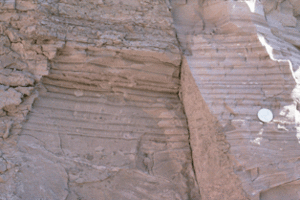
- Some strata show repeating patterns, like stripes. These are called rhythmites. If the patterns are caused by yearly changes, like seasons, they’re called varves.
- Sometimes, layers are missing. This happens because of erosion or other forces. These gaps are called unconformities. They help geologists understand how the Earth’s surface has changed.
- In some places, like mountains, strata can be bent or folded. This happens because of huge forces inside the Earth. For example, when tectonic plates crash together.
Images for kids
-
Stair Hole from the East. This hole on the Jurassic Coast behind the cliff shows twisted rock layers.
-
Goldenville strata in a quarry in Bedford, Canada. These are Middle Cambrian ocean sediments. This rock formation covers over half of Nova Scotia. It is recorded as being 29,000 feet thick in some areas.
-
The Permian through Jurassic strata in the Colorado Plateau area of southeastern Utah shows how layers are formed. These layers make up many famous rock formations. You can see them in places like Capitol Reef National Park and Canyonlands National Park. From top to bottom: Rounded tan domes of the Navajo Sandstone, layered red Kayenta Formation, cliff-forming, vertically jointed, red Wingate Sandstone, slope-forming, purplish Chinle Formation, layered, lighter-red Moenkopi Formation, and white, layered Cutler Formation sandstone. Picture from Glen Canyon National Recreation Area, Utah.
See also
 In Spanish: Estrato para niños
In Spanish: Estrato para niños




